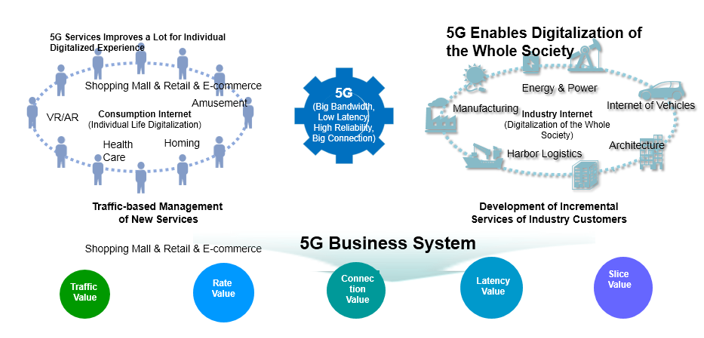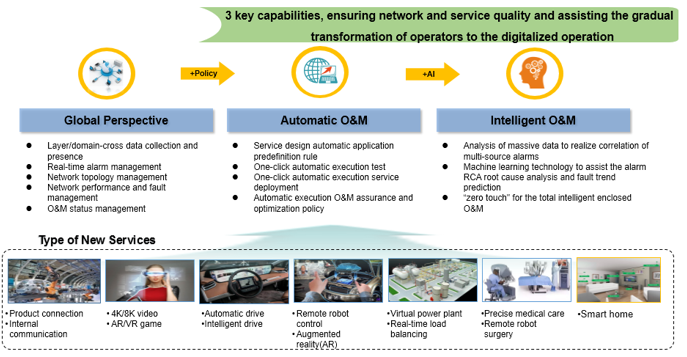Build an Elite 5G Core Network with Rigidity and Flexibility
Time:2019-06-27
2019 is recognized as the first year of 5G. On April 5th, SK Telecom, KT and LG U+ in South Korea officially launched 5G network commercial services for general consumers. Immediately thereafter, the Federal Communications Commission (FCC) announced on April 16 that it will hold its third millimeter-wave spectrum auction program and promised to invest more than $20 billion to deploy 5G in rural areas. In the morning of June 6th, the Ministry of Industry and Information Technology from China officially issued 5G commercial licenses. China 5G ushered in a substantial step, announcing that China will officially enter the 5G commercial year.
The 5G network commercial wave has been gradually opened in the world. As the core network of the network control center, it needs to be rigid and flexible, and cast 5G elite core network to protect operators in 5G network commercial escort.
”Rigidity”
In recent years, the black swan events in the telecommunications network have been frequent, and the 5G era will connect 7 billion people and trillions of equipment as the infrastructure of the industrial Internet, which means that any failure may cause serious destructive events.
The importance of the “rigid” network to the commercialization of 5G networks is self-evident. How to provide a “rigid” network requires protection from both product mechanisms and technologies.
From the perspective of the product mechanism, product selection needs to be diversified to avoid systemic risks or supply chain bottlenecks. Once systemic risks occur across the network, the impact on the network is enormous.
From the aspect of the product technology, it can be guaranteed by the following aspects.
- High-reliability service processing: The stateless cloudified architecture adopts unified data storage to implement service processing and data separation. The N+M load sharing mode replaces the original 1+1 active/standby mode, reducing costs and improving resource utilization. It realizes second-level scaling-up/down, promoting the user experience and network O&M reliability.
- High reliability of data storage: Unified storage and management is made for online data sharing. The flexible synchronization mechanism is provided to ensure data consistency. Synchronous replication is made when network QoS is good; asynchronous replication is made when network QoS is poor. The four-level backup and recovery guarantees the data security and reliability. The memory, disk array, local hard disk, and external storage device are composed of four guarantee layers while the user's dynamic data and static data are saved in real time.
- Rich disaster recovery networking modes: Data storage supports N+K geographical disaster recovery to meet different application scenarios. Access network elements flexibly take over services within the set according to weight. The multi-user-plane and multi-control-plane hybrid networking can guarantee that the user can still access normally if any network element fails.
”Flexibility”
5G is not only a pipeline, but also an innovation for a business mode, a change for service methods and an integration innovation for vertical services. The “soft” 5G core network is increasingly important. At the same time, technologies (AICDE) such as AI, IoT, cloud computing, big data and edge computing are also booming. The 5G network that combines these technologies is no longer comparable to traditional networks. 5G is not only adopted by the industry, but also expected by the whole society.
5G network can provide big bandwidth, low latency, big connection, and high reliability. These performances and features are either 10x or tens of times 4G, or not available with 4G. 4G changes life while 5G changes society. 5G not only upgrades the existing 4G business, but also enhances the personal digital experience and spawns new business. Typical new services include Cloud AR/VR, Cloud Gaming, personal video live broadcast and other immersive real-time video services. These services are only the first wave of 5G applications, which are the natural evolution of 4G MBB to 5G eMBB, solving the bandwidth business capacity requirements with lower bit costs.
With the introduction of uRLLC and mMTC, 5G will also bring about the industrial transformation of IoT, providing auto-driving based on Internet of Vehicles, intelligent manufacturing based on drones and industrial robots, telemedicine based on low-latency connections, smart city, smart agriculture and other industrial applications.

Figure 1 5G Service Development and Business Mode
The goal of 5G network is to achieve the transmission latency of service exposing time at minute level within tens of milliseconds, providing users with a visual, optional and self-service network experience. In the 5G era, the traditional network operation and maintenance methods have become inadequate.
Firstly, due to the introduction of SDN/NFV technology, network devices are virtualized, and service functions and connections can be dynamically loaded and orchestrated. The network will no longer be a simple domain, but a horizontal domain and a vertical layered cloud network. The difficulties of automatic deployment, testing, upgrade, monitoring, optimization, and cross-layer cross-domain fault positioning of network elements and services will increase significantly.
Secondly, 5G network is a distributed network to separate control from forwarding. In order to improve resource utilization, operation and maintenance efficiency, and speed of service delivery, centralized deployment of control planes will become a trend. Centralized deployment and centralized operation and maintenance will inevitably pose challenges to the existing organizational structure, operation and maintenance process, and network management system.
Thirdly, the existing network has a high probability of being a multi-vendor equipment environment. It is also an urgent problem to be solved on how to implement unified management and automatic end-to-end orchestration of multi-vendor equipment including access, transmission, and core network, and unify the network capability API to realize network capability exposing and end-to-end slicing operations.

Figure 2 3 Key Capabilities of 5G Network O&M
5G network must introduce new technologies to achieve automated and intelligent network operation and maintenance. Global perspective, automatic operation and maintenance and intelligent operation and maintenance are the three key capabilities of 5G network operation and maintenance. The global perspective capability should include cross-layer and cross-domain data collection and presentation, real-time alarm management, network topology management, network performance fault management, and operation and maintenance operation state management capabilities. Automatic operation and maintenance should include predefined rules of business design and automatic applications, one-click automatic test execution, one-click automatic execution of service deployment, automatic operation and maintenance guarantee and optimization policy. Intelligent operation and maintenance should include massive data intelligent analysis, adopting multi-source alarm correlation and machine learning technology to assist alarm RCA root cause analysis and failure trend forecasting.
At present, the automation of 5G network operation and maintenance is still in the end-to-end automatic deployment and orchestration stage of single-vendor equipment, and end-to-end automation of multiple venders is still exploring. The intelligentization of network operation and maintenance is just getting started. It is still far from the 5G network to realize the “Zero Touch” network closed-loop intelligent operation and maintenance and “satisfactory” network. However, the more confused, the more you have to look into the distance, and the more you can see the future in the flood.
The scale of 5G network commercialization requires a flexible core network to promote 5G to a healthy track through “quantitative change + qualitative change”.
The Internet was born in 1969, and this year is exactly the 50th anniversary. This year is the 5G first year, so the "50th anniversary" encounters the "5G first year". As the key to support 5G network construction and carry 5G services, 5G core network faces the wave of commercialization of 5G networks of mainstream operators around the world. ZTE's core network products are brave to explore and practice, adhering to the “rigid” network as the core and “flexible” networks. For the operator to cast 5G elite core network, headed into the era of 5G Internet of Everything.

